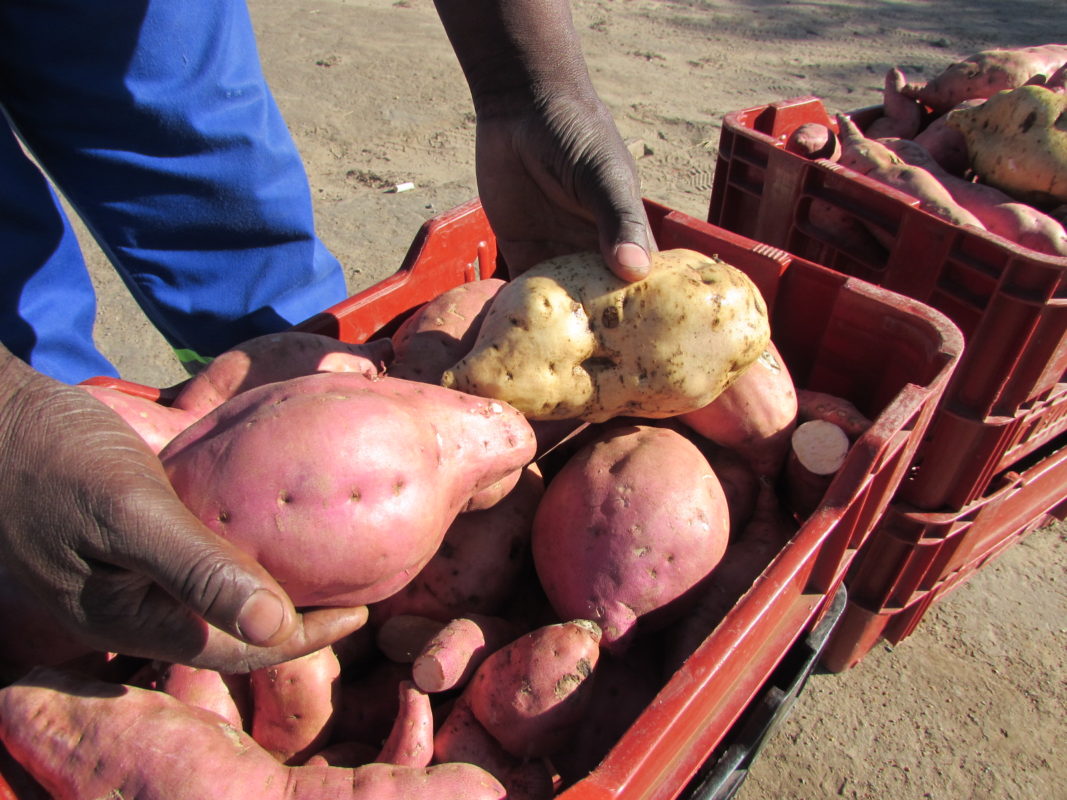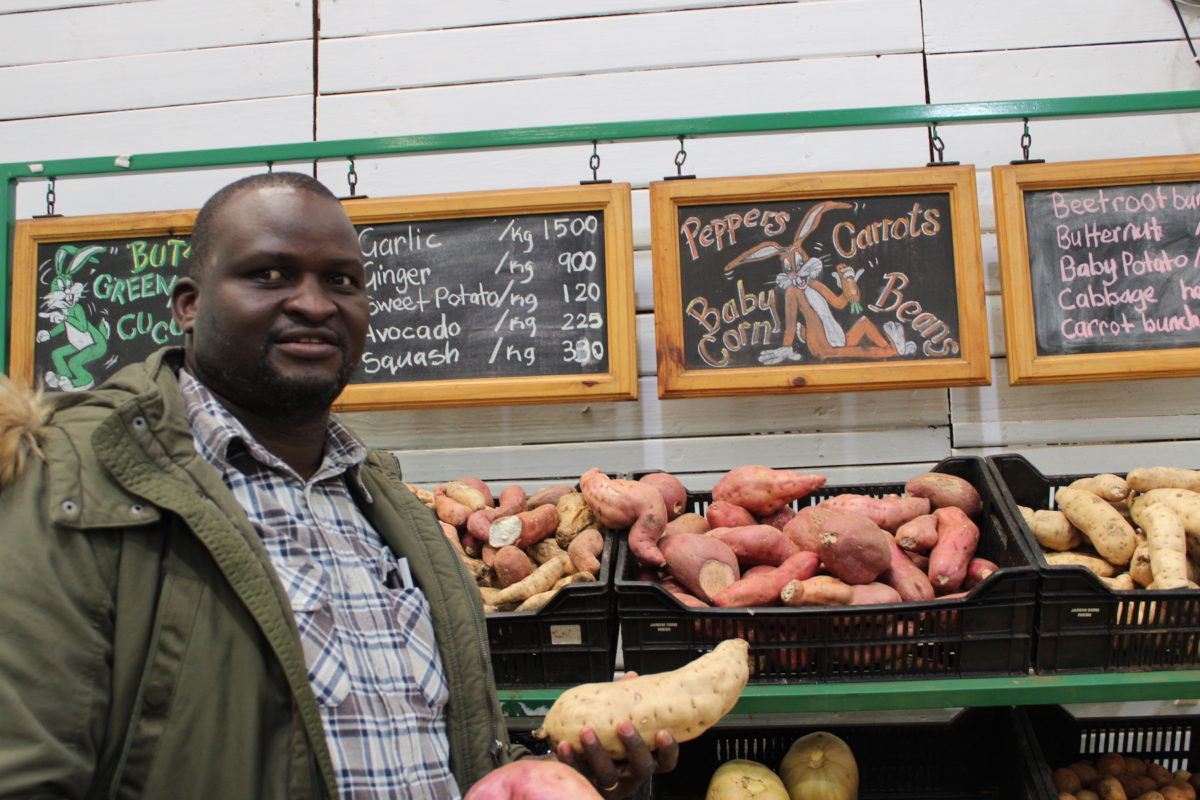An iron digger adapted from a motor vehicle spring thrusts effortlessly deep into the sides of green vines covering an earth mound.
With the care of an archaeologist, farmhand Simbarashe Ncube meticulously scoops up the loosened lumps of grey soil to dislodge a copper-colored sweet potato that barely fits into his hand. He gently pulls out the tuber and leaves it on the scattered mound, exposing it to the scorching mid-day sun. He digs the next leafy vine.
“The sun helps firm the skin so the tubers do not bruise when handled from the field. They need a gentle touch,” explains Shadreck Zhou, a smallholder farmer who has put down roots in rain-fed sweet potato production in Southern Zimbabwe, a semi-arid area with a harsh history of droughts and high temperatures.
Troubled by frequent droughts and high temperatures that have made growing the staple crop maize (corn) more challenging, smallholder farmers in Zimbabwe have hit upon an underground sweet spot in boosting food security and beating climate change with sweet potatoes.
Classified as tubers, sweet potatoes are a nutritious, climate-resilient crop and a root source of steady income for smallholder farmers.
Bred to absorb natural shocks
Sweet potatoes have been improved through conventional selecting breeding methods. The breeding process involves crossing different sweet potato varieties with selected traits such as health benefits, taste, size, pest- and disease-resistance and drought-tolerance.

But conventional crop breeding is a lengthy and expensive process. The International Potato Centre (CIP), a global research organization, based in Peru, has achieved a breeding feat by speeding up conventional breeding processes to produce new sweet potato varieties.
Using the accelerated breeding scheme, the CIP has halved the time it takes to produce new varieties, reducing the lengthy of the process from eight or 10 years to just five, according to Jan Low, a principal scientist at CIP who was named a World Food Prize Laureate for her efforts in breeding and disseminating the orange sweet-fleshed potato.
There are more than 400 genetically diverse sweet potatoes across the world and they come in a wide assortment of colors, shapes and sizes. Many people in Africa have been accustomed to white flesh sweet potatoes, whose origins are traced to South America in the 1600s. However, these varieties lack beta carotene — a red-orange pigment found in some fruits and plants — which the body converts into vitamin A.
Since 2009, CIP’s research has produced 62 orange-fleshed varieties that have been released by 12 African countries, Low said.
“Sweet potatoes are a critical food security crop, known as the crop that is there when the maize fails,” Low told the Alliance for Science, adding that the tubers are more water-efficient than grain crops. They give a higher energy output per unit area and time than other staple foods.
Since sweet potatoes have a short growing cycle and develop underground they are less susceptible than other crops to extreme weather like droughts, heavy rain and strong winds. They provide food quickly, especially for resource-poor households during disasters.
Sweet potato is often used in disaster recovery efforts because it can produce edible roots in four months, with the leaves ready for eating in a month, Low said. Sweet potato leaves are rich in lutein, a naturally occurring pigment made by plants and algae that prevents eye degeneration.
Breeding efforts have also focused on obtaining more early-maturing varieties that enable production of an edible crop in four months, a useful trait when the length of growing seasons has become increasingly unpredictable, Low said.
Farmers reap sweet benefits
Zhou, 46, and his wife, Melody, have been growing sweet potatoes on six hectares of their 20-hectare farm for the past five years.
A marketing and entrepreneurship trainer, Zhou found food and financial fortune in sweet potato production. He earned $5,000 from his first hectare of sweet potatoes in 2015 and invested it in a solar-powered borehole (well). Subsequent harvests have enabled him to diversify his agriculture production into rearing free-range chickens, rabbits and cattle.

“I went into sweet potato production when I realized a high appetite for sweet potatoes in market, ” Zhou said in an interview at his farm, 40 kilometers north of the city of Bulawayo.
“Sweet potatoes are a drought-tolerant crop and it was ideal for me to grow them in this region with far much less investment than I would need with other crops, like maize, which is sensitive to water,” said Zhou, who invested nearly $2,000 in vines, equipment and labor to start sweet potato farming.
Zhou is growing nutritionally enhanced sweet potato varieties, including Irene, with red skin and orange flesh, and Beauregard, which has orange skin and flesh. These varieties have been developed using biofortification, a process that manipulates the genetic make-up of crops to increase their nutritional value through conventional breeding.
In addition, he grows other sweet potato varieties with particular traits, like the Brondal, a red skin, white flesh cultivar with big tubers suitable for processing into chips. The German 2 is a pink skin, white flesh variety that Zhou describes as the sweetest and a market favorite. He also grows Chingova, a very sweet variety with white skin and white flesh.
Firm market prices for sweet potatoes have also been an incentive for Zhou to produce sweet potato. In the 2016-17 season he harvested 16 tonnes of the crop and sold it for $800 per tonne. In the 2020-21 season he is expecting to harvest more than 30 tonnes of sweet potatoes.
“The price could be lower this year because there was a lot of rain in the last season and more farmers produced sweet potatoes. I expect a glut on the informal market to affect the price,” says Zhou, who sells his produce directly to retailers in the city. Currently he supplies nine supermarket outlets.
“To get ahead of the competition, we deliberately focused on selling our sweet potatoes to formal retailers where we have established a niche market.”
In Zimbabwe, sweet potatoes have become a flagship commodity especially among smallholder farmers.
More than one million smallholder farmers in the country produce around 420,000 MT of sweet potato annually, according to Simbarashe Muchena, a commodities executive with the Zimbabwe Farmers Union (ZFU).
“Though sweet potato is a low-cost enterprise to venture into there is still need for mechanisms to support farmers in accessing improved and clean planting materials,” Muchena said.
Rooting for nutrition
Malnutrition, a result of deficiencies of essential micro nutrients like zinc, iodine and vitamin A in the diet, is a threat to millions of lives in Africa and Asia, according to the United Nation’s Food and Agriculture Organisation (FAO).
While the World Health Organization (WHO) says more than 2 billion people are affected by micronutrient deficiencies around the world.
One in four children in Zimbabwe has a vitamin A deficiency, according to the Ministry of Health and Child Care, citing high levels of stunting that affect children’s growth and brain development.
Furthermore, 23 percent of women of children-bearing age suffer from vitamin A deficiency (VAD), a condition that can be corrected by the provision of micronutrient-rich foods, such as orange sweet potatoes (OSP). OSP varieties have high vitamin A as well as zinc and iron, making them ideal root crops in improving food and nutrition security.
The CIP has focused on developing adapted orange-fleshed varieties that are rich in pro-vitamin A. Africa is burdened with a high prevalence of vitamin A deficiency among children under 5 years of age One small root (125 gram) of OSP meets the daily vitamin A needs of a young child.
Sweet potato is the seventh-most important crop in Africa, making it a prime source of income, food and nutrition for smallholder farmers during challenging circumstances, according to CIP.
“If you have not tried sweet potatoes you are denying yourself potential for success,” Zhou noted. “Any farmer starting out needs to explore sweet potatoes. It is a handy crop, easy to grow and environmentally friendly because every part of the crop is used.”
Image: Harvesting sweet potatoes in Zimbabwe. Photo: Busani Bafana
